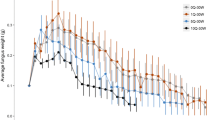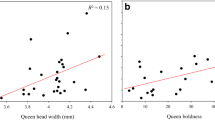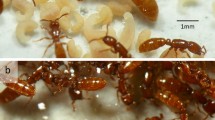Abstract
Colony size in social insects is one of the most important factors in shaping their self-organized system. It affects a wide variety of traits such as foraging and defense strategies, social immune responses, the degree of polymorphism, and reproductive output. However, colony size estimation of subterranean termites in the field has been challenging, due to their extremely cryptic biology and multiple site–nesting behavior. Since natural selection favors workers that maximize the number of their siblings, the amount of egg production may reflect the number of workers in the colony. Here, we report a method for inferring colony size in the field using total egg production in each colony from a subterranean termite, Reticulitermes speratus. Our investigation of field colonies revealed that the body weight of queens reaches a peak and had the largest variance in June and July and accurately predicts the number of eggs laid by the queen per 24 h. Using laboratory-reared colonies, we found that the total egg production in each colony is proportional to the number of workers. We also estimated the colony size of 198 field colonies and found that the median and maximum colony size was 24,500 and 451,800 workers per colony. The method for inferring colony size presented here may also be applicable to termite species with a clear seasonality in egg production. The colony size estimate will contribute to understanding the life history strategies and social systems of termites.





Similar content being viewed by others
Data availability
All data generated or analyzed during this study are included in this published article.
Code availability
The codes for graphing and statistical analyses used for this paper are available at GitHub (https://github.com/MamoruTakata/Colony_size_estimate).
References
Abe T (1987) Evolution of life types in termites. In: Kawano S, Connell JH, Hidaka T (eds) Evolution and coadaptation in biotic communities. University of Tokyo Press, Tokyo, Japan, pp 125–148
Beshers SN, Fewell JH (2001) Models of division of labor in social insects. Annu Rev Entomol 46:413–440. https://doi.org/10.1146/annurev.ento.46.1.413
Boomsma JJ, Gawne R (2018) Superorganismality and caste differentiation as points of no return: how the major evolutionary transitions were lost in translation. Biol Rev 93:28–54. https://doi.org/10.1111/brv.12330
Bourke AFG (1999) Colony size, social complexity and reproductive conflict in social insects. J Evol Biol 12:245–257. https://doi.org/10.1046/j.1420-9101.1999.00028.x
Chouvenc T, Ban PM, Su N-Y (2022) Life and death of termite colonies, a decades-long age demography perspective. Front Ecol Evol 10:1–21. https://doi.org/10.3389/fevo.2022.911042
Darlington JPEC (1990) Populations in nests of the termite Macrotermes subhyalinus in Kenya. Insectes Soc 37:158–168. https://doi.org/10.1007/BF02224028
Dornhaus A, Powell S, Bengston S (2012) Group size and its effects on collective organization. Annu Rev Entomol 57:123–141. https://doi.org/10.1146/annurev-ento-120710-100604
Eggleton P (2000) Global patterns of termite diversity. In: Abe T, Bignell DE, Higashi M (eds) Termites, evolution, sociality, symbioses, ecology. Springer, Netherlands, Dordrecht, pp 25–51
Eggleton P, Williams PH, Gaston KJ (1994) Explaining global termite diversity: productivity or history? Biodivers Conserv 3:318–330. https://doi.org/10.1007/BF00056505
Emerson AE (1955) Geographic origins and dispersion of termite genera. Fieldiana Zool 37:465–521
Evans TA, Forschler BT, Grace JK (2013) Biology of invasive termites: a worldwide review. Annu Rev Entomol 58:455–474. https://doi.org/10.1146/annurev-ento-120811-153554
Evans TA, Lenz M, Gleeson PV (1999) Estimating population size and forager movement in a tropical subterranean termite (Isoptera: Rhinotermitidae). Environ Entomol 28:823–830. https://doi.org/10.1093/ee/28.5.823
Grace JK, Abdallay A, Farr KR (1989) Eastern subterranean termite (Isoptera: Rhinotermitidae) foraging territories and populations in Toronto. Can Entomol 121:551–556. https://doi.org/10.4039/Ent121551-7
Haverty MI, Nutting WL, Lafage JP (1975) Density of colonies and spatial distribution of foraging territories of the desert subterranean termite, Heterotermes aureus (Snyder). Environ Entomol 4:105–109. https://doi.org/10.1093/ee/4.1.105
Hölldobler B, Wilson EO (2009) The superorganism: the beauty, elegance, and strangeness of insect societies. W. W, Norton, New York
Howard RW, Jones SC, Mauldin JK, Beal RH (1982) Abundance, distribution, and colony size estimates for Reticulitermes spp. (Isoptera: Rhinotermitidae) in southern Mississippi. Environ Entomol 11:1290–1293. https://doi.org/10.1093/ee/11.6.1290
Inagaki T, Matsuura K (2016) Colony-dependent sex differences in protozoan communities of the lower termite Reticulitermes speratus (Isoptera: Rhinotermitidae). Ecol Res 31:749–755. https://doi.org/10.1007/s11284-016-1387-2
Kennedy P, Baron G, Qiu B et al (2017) Deconstructing superorganisms and societies to address big questions in biology. Trends Ecol Evol 32:861–872. https://doi.org/10.1016/j.tree.2017.08.004
Kenneth Grace J, Yamamoto RT, Tamashiro M (1995) Relationship of individual worker mass and population decline in a Formosan subterranean termite colony (Isoptera: Rhinotermitidae). Environ Entomol 24:1258–1262. https://doi.org/10.1093/ee/24.5.1258
King EG, Spink WT (1969) Foraging galleries of the Formosan subterranean termite, Coptotermes formosanus, in Louisiana. Ann Entomol Soc Am 62:536–542. https://doi.org/10.1093/aesa/62.3.536
Konishi T, Tasaki E, Takata M, Matsuura K (2023) King- and queen-specific degradation of uric acid contributes to reproduction in termites. Proc R Soc B Biol Sci 290:20221942. https://doi.org/10.1098/rspb.2022.1942
La Fage JP, Su N-Y, Jones MJ, Esenther GR (1983) A rapid method for collecting large numbers of subterranean termites from wood. Sociobiology 7:305–309
Matsuura K, Kobayashi N, Yashiro T (2007) Seasonal patterns of egg production in field colonies of the termite Reticulitermes speratus (Isoptera: Rhinotermitidae). Popul Ecol 49:179–183. https://doi.org/10.1007/s10144-006-0030-4
Matsuura K, Mizumoto N, Kobayashi K et al (2018) A genomic imprinting model of termite caste determination: not genetic but epigenetic inheritance influences offspring caste fate. Am Nat 191:677–690. https://doi.org/10.1086/697238
Matsuura K, Vargo EL, Kawatsu K et al (2009) Queen succession through asexual reproduction in termites. Science 323:1687–1687. https://doi.org/10.1126/science.1169702
Nozaki T, Matsuura K (2021) Oocyte resorption in termite queens: seasonal dynamics and controlling factors. J Insect Physiol 131:104242. https://doi.org/10.1016/j.jinsphys.2021.104242
Oster GF, Wilson EO (1978) Caste and ecology in the social insects. Princeton University Press, Princeton, NJ
Park YC, Kitade O, Schwarz M et al (2006) Intraspecific molecular phylogeny, genetic variation and phylogeography of Reticulitermes speratus (Isoptera: Rhinotermitidae). Mol Cells 21:89–103
Patel JS, Lee S-B, Chouvenc T, Su N-Y (2020) Inferring termite colony size using wood consumption in subterranean termites (Blattodea: Rhinotermitidae) in laboratory-rearing conditions. J Econ Entomol 113:905–910. https://doi.org/10.1093/jee/toz353
R Core Team (2022) R: a language and environment for statistical computing. R Foundation for Statistical Computing
Shellman-Reeve JS (1997) The spectrum of eusociality in termites. In: Choe JC, Crespi BJ (eds) Evolution of social behavior in insects and arachnids. Cambridge University Press, Cambridge, UK, pp 52–93
Shimada K, Lo N, Kitade O et al (2013) Cellulolytic protist numbers rise and fall dramatically in termite queens and kings during colony foundatio. Eukaryot Cell 12:545–550. https://doi.org/10.1128/EC.00286-12
Spragg WT, Paton R (1980) Tracing, trophallaxis and population measurement of colonies of subterranean termites (Isoptera) using a radioactive tracer. Ann Entomol Soc Am 73:708–714. https://doi.org/10.1093/aesa/73.6.708
Su N-Y (2003) Behavioral ecology of foraging in subterranean termites. In: Bignell DE, Roisin Y, Lo N (eds) Biology of termites: a modern synthesis. Springer, Dordrecht, Netherlands, pp 165–191
Su N-Y (1994) Field evaluation of a hexaflumuron bait for population suppression of subterranean termites (Isoptera: Rhinotermitidae). J Econ Entomol 87:389–397. https://doi.org/10.1093/jee/87.2.389
Su N-Y (2013) Estimating population size of large laboratory colonies of the Formosan subterranean termite using the capture probability equilibrium. J Econ Entomol 106:2442–2447. https://doi.org/10.1603/EC13258
Su N-Y, Ban PM, Scheffrahn RH (1993) Foraging populations and territories of the eastern subterranean termite (Isoptera: Rhinotermitidae) in southeastern Florida. Environ Entomol 22:1113–1117. https://doi.org/10.1093/ee/22.5.1113
Su N-Y, Lee S-H (2008) Estimating the population size and colony boundary of subterranean termites by using the density functions of directionally averaged capture probability. J Econ Entomol 101:592–604. https://doi.org/10.1093/jee/101.2.592
Su N-Y, Osbrink W, Kakkar G et al (2017) Foraging distance and population size of juvenile colonies of the Formosan subterranean termite (Isoptera: Rhinotermitidae) in laboratory extended arenas. J Econ Entomol 110:1728–1735. https://doi.org/10.1093/jee/tox153
Su N-Y, Scheffrahn RH (1988) Foraging population and territory of the Formosan subterranean termite (Isoptera: Rhinotermitidae) in an urban environment. Sociobiology 14:353–359
Takata M, Konishi T, Nagai S et al (2023a) Discovery of an underground chamber to protect kings and queens during winter in temperate termites. Sci Rep 13:8809. https://doi.org/10.1038/s41598-023-36035-1
Takata M, Nagai S, Inagaki T et al (2023b) Heritable effects on caste determination and colony-level sex allocation in termites under field conditions. iScience 26:106207. https://doi.org/10.1016/j.isci.2023.106207
Takematsu Y (1999) The genus Reticulitermes (Isoptera: Rhinotermitidae) in Japan, with description of a new species. Entomol Sci 2:231–243
Tasaki E, Mitaka Y, Takahashi Y et al (2023) The royal food of termites shows king and queen specificity. PNAS Nexus. https://doi.org/10.1093/pnasnexus/pgad222
Thorne BL (1997) Evolution of eusociality in termites. Annu Rev Ecol Syst 28:27–54. https://doi.org/10.1146/annurev.ecolsys.28.1.27
Thorne BL, Russek-Cohen E, Forschler BT et al (1996) Evaluation of mark–release–recapture methods for estimating forager population size of subterranean termite (Isoptera: Rhinotermitidae) colonies. Environ Entomol 25:938–951. https://doi.org/10.1093/ee/25.5.938
Tsunoda K, Matsuoka H, Yoshimura T, Tokoro M (1999) Foraging populations and territories of Reticulitermes speratus (Isoptera: Rhinotermitidae). J Econ Entomol 92:604–609. https://doi.org/10.1093/jee/92.3.604
Wilson EO (1971) The insect societies. Belknap Press, Cambridge, Massachusetts
Acknowledgements
We thank Matthew Tatsuo Kamiyama for the fruitful discussion, and Wu Yao, Chihiro Tamaki, Takehiro Morimoto, Hiroki Noda, Shuya Nagai for assistance in collecting termites and helpful discussion.
Funding
This work was supported by JSPS KAKENHI Grant Numbers JP18H05268, JP20K20380, and JP23H00332 to K.M., JP21K14863 to M.T., and JP20J20278 to T.K.
Author information
Authors and Affiliations
Contributions
Conceptualization, M.T.; methodology, M.T. and K.Y.; validation, M.T.; formal analysis, M.T.; investigation, M.T., K.Y., T.N. S.M., T.K., and E.T.; resources, M.T., K.Y., T.N. S.M., T.K., and E.T.; writing—original draft: M.T.; writing—review and editing: M.T., K.Y., T.N. S.M., T.K., E.T., and K.M.; visualization, M.T. and T.K.; supervision, M.T. and K.M.; project administration, M.T.; funding acquisition, M.T., T.K., and K.M.
Corresponding author
Ethics declarations
Ethics approval
Not applicable.
Consent to participate
Not applicable.
Consent for publication
Not applicable.
Competing interests
The authors declare no competing interests.
Additional information
Communicated by: Sean O'Donnell
Publisher’s note
Springer Nature remains neutral with regard to jurisdictional claims in published maps and institutional affiliations.
Supplementary information
ESM 1
(XLSX 348 kb)
Rights and permissions
Springer Nature or its licensor (e.g. a society or other partner) holds exclusive rights to this article under a publishing agreement with the author(s) or other rightsholder(s); author self-archiving of the accepted manuscript version of this article is solely governed by the terms of such publishing agreement and applicable law.
About this article
Cite this article
Takata, M., Yabe, K., Noro, T. et al. A method for estimating colony size using queen fecundity in termites under field conditions. Sci Nat 110, 35 (2023). https://doi.org/10.1007/s00114-023-01865-6
Received:
Revised:
Accepted:
Published:
DOI: https://doi.org/10.1007/s00114-023-01865-6




